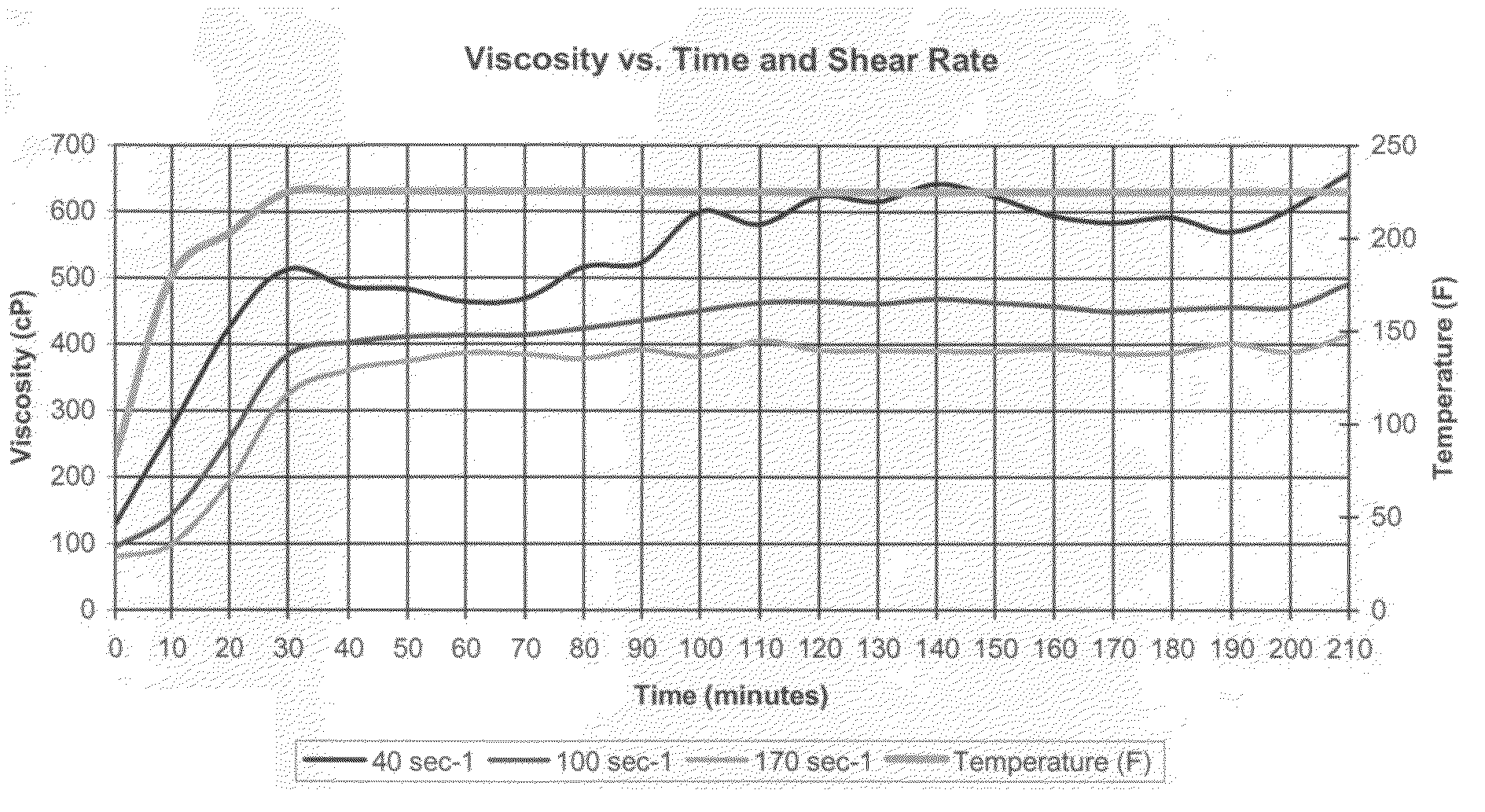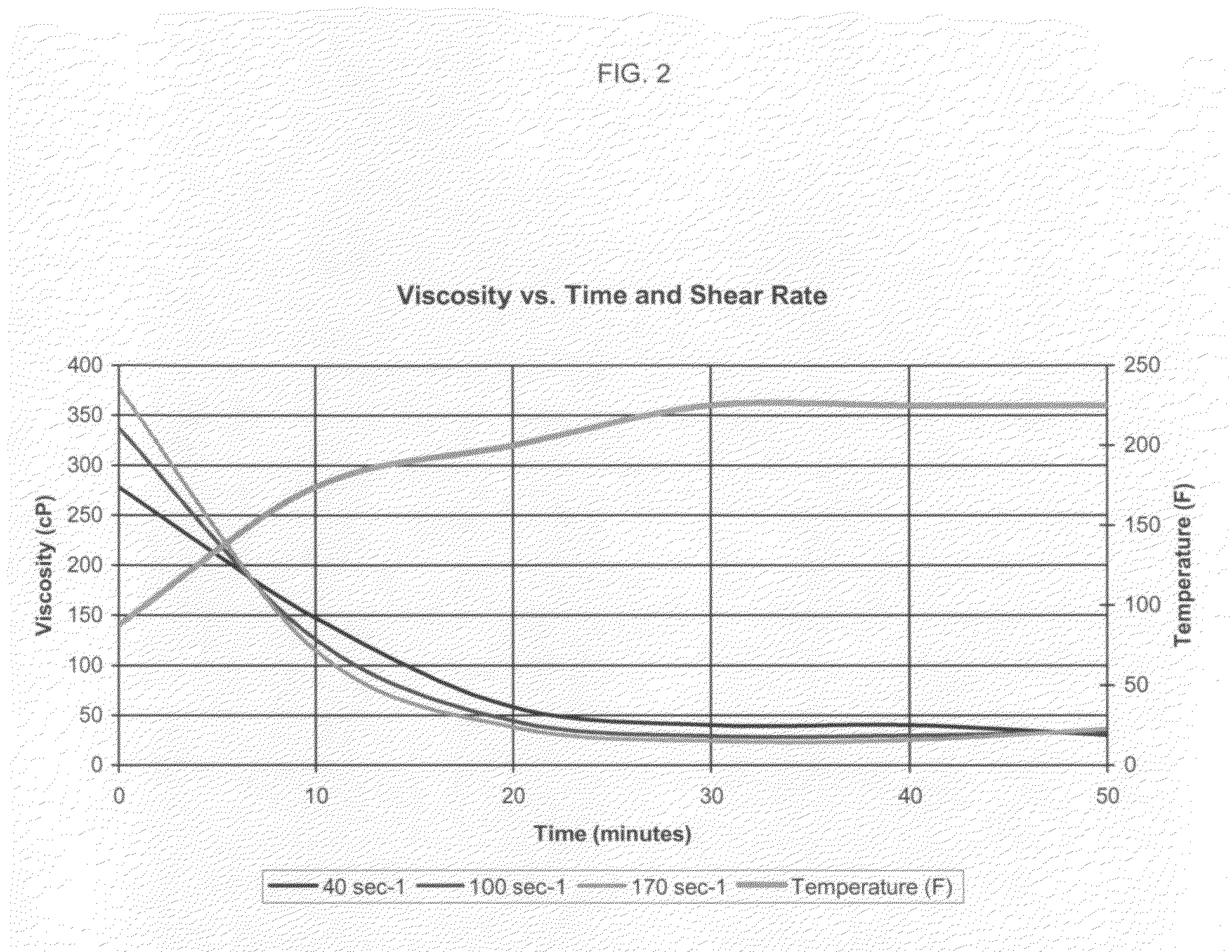Method of treating a well and a subterranean formation with alkali nitrate brine
a technology of alkali nitrate brine and wellbore treatment, which is applied in the direction of wellbore/well accessories, sealing/packing, chemistry apparatus and processes, etc., can solve the problems of affecting the operation of wellbore treatment, the thermal stability of aqueous well treatment fluids containing viscosifying polymers is often compromised, and the viscosity of well treatment fluids is often reduced, so as to achieve the effect of partial applicability
- Summary
- Abstract
- Description
- Claims
- Application Information
AI Technical Summary
Benefits of technology
Problems solved by technology
Method used
Image
Examples
example 1
[0042]A solution was prepared by mixing 0.908 bbl of 12.5 ppg NaBr and 72.7 ppb of 99.9% sodium nitrate. The sodium nitrate completely dissolved and the solution was measure to have a density of 13.12 ppg at 76° F. The crystallization temperature of the fluid was measured to be 60° F.
example 2
[0043]To the solution in Example 1, 40 Ib / Mgal (1.68 ppb) of guar gum was added using an overhead stirrer. The solution reached maximum viscosity at 511 l / sec of 55 cp. in 15 minutes. The fluid without the guar gum had a viscosity of 3.6 cp. at 511 l / sec. The pH of the fluid was raised to 11.2 with 25% by weight NaOH and 0.15 ppb of sodium tetraborodecahydrate was added to crosslink the guar gum. The fluid was then heated to 180° F. and the rheologies measured on an OFI Model 900 viscometer at 180° F. The viscosities at shear rates of 1022, 511, 340, 170, 10, 5 l / sec is 85, 120, 169, 278, 1,100 and 1,420 cp., respectively, indicating that the fluid was crosslinked.
example 4
[0046]A brine slurry was prepared containing 40 ppg of GW-3LE guar in 13.1 ppg sodium bromide / sodium nitrate and mixed for 30 minutes using an overhead stirrer. To the fluid was then added, 4.5 gallons per thousand gallons of BF-9L, 0.10 gallons per thousand gallons of BF-10L. 3.0 gallons per thousand gallons of XLW-56 and 1.0 gallons of a borate crosslinking agent, commercially available from BJ Services Company as XLW-32 was also added along with 8.0 pounds per thousand gallons of sodium thiosulfate oxygen scavenger and 0.50 pounds per thousand gallons of a peroxide delayed release oxidative breaker, commercially available as GBW-24 from BJ Services Company. Thereafter, 65 ml sample of the fluid was placed into a Fann 50 viscometer cup having a bob (BX5) and rotor (R1) cup assembly fluid viscosity calculated as set forth in Example 3 above. The results are shown in Table II. The initial viscosity was 87 cP at 76° F.
[0047]
TABLE IITimeTemperatureK′40 1 / sec100 1 / sec170 1 / secMinutes° ...
PUM
| Property | Measurement | Unit |
|---|---|---|
| density | aaaaa | aaaaa |
| temperature | aaaaa | aaaaa |
| temperature | aaaaa | aaaaa |
Abstract
Description
Claims
Application Information
 Login to View More
Login to View More - R&D
- Intellectual Property
- Life Sciences
- Materials
- Tech Scout
- Unparalleled Data Quality
- Higher Quality Content
- 60% Fewer Hallucinations
Browse by: Latest US Patents, China's latest patents, Technical Efficacy Thesaurus, Application Domain, Technology Topic, Popular Technical Reports.
© 2025 PatSnap. All rights reserved.Legal|Privacy policy|Modern Slavery Act Transparency Statement|Sitemap|About US| Contact US: help@patsnap.com



